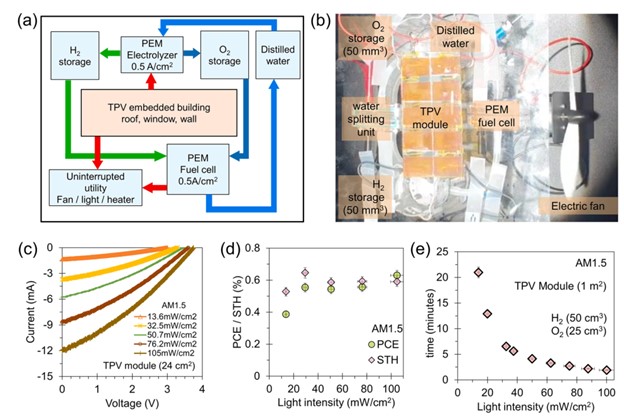From pv magazine International
A Korean-U.S. research group has created a system to produce and store green hydrogen via transparent PV (TPV) cells and transparent photo-electrochemical (TPEC) cells that could be integrated into buildings.
“We proposed a transparent, sustainable energy platform,” the research’s corresponding author, Joondong Kim, told pv magazine. “Our proposed system benefits the levelized cost of solar hydrogen by on site production and building integration and offers affordable solar hydrogen for domestic applications.”
The system is claimed to have a high average visible transmittance of around 64% and remarkable color neutrality, which the scientists said has a close chromaticity to the light source. “To ensure its suitability in building-integration, especially for windows, the visual appearance of TPV and TPEC is a fundamental issue,” the researchers noted.
The system’s solar power generator is based on 1.47%-efficient transparent metal oxide solar cells built with n-doped zinc oxide (N:ZnO) and p-doped nickel(II) oxide (p-NiO) on a glass substrate made of indium tin oxide (ITO). These cells are able to generate a high photovoltage of 0.546V and work as a photoanode to provide a stable photocurrent density of 2.28mA/cm2 in the TPEC system.
The PEC cell was fabricated with a TPEC photoanode as the positive terminal and platinum wire as the negative terminal. “Short wavelength UV with highly-energetic photons was mostly absorbed in the photoanode, with an efficiency as high as 82%,” the academics emphasized.
A proton exchange membrane fuel cell (PEMFC) is linked to the TPV-TPEC module, with the latter working as a hydrogen generator and the former being used as an axial medium to convert the hydrogen to electric power. These two systems are complementary to each other and complete the closed-loop energy supply chain, which can supply power without interruption. “In the daytime, the PV can supply electric power directly to the building and produce hydrogen for energy storage,” the researchers explained. “Hydrogen fuel is an efficient energy storage method and can be used during the night time or in periods when the PV system is disabled.”
The closed-loop system was experimentally demonstrated by connecting it to a 10mW electric fan. The PV cells provide power to operate the fan and, at the same time, the TPEC/PEM electrolyzer unit. The stored hydrogen is then used by the PEMFC, to produce more electric power to move the fan. Performance profiles of the solar cells were obtained by varying light intensity from 13.6 to 105mW/cm2. “The TPV-TPEC-PEMFC system is solid to provide the constant power supply to operate the fan without any interruption,” the research team stated. “The uncertainty of the light-dependent electric power production can be resolved by the merit of the energy circulation system of [the] TPV-TPEC-PEMFC [system].”
“This is the first demonstration of a TPV-PEC-fuel cell application, which suggests the potential for a transparent energy system as a building-integrated, uninterrupted, pollution-free energy supply,” Kim told pv magazine. “The proposed system is readily available for building structures that provide niche aesthetics, including angle-dependent transmittance, see-through features, UV blocking, and on site power production.”
The system is described in the study “Transparent sustainable energy platform: Closed-loop energy chain of solar-electric-hydrogen by transparent photovoltaics, photo-electro-chemical cells and fuel system,” which was recently published in Nano Energy. The research group includes scientists from the Multidisciplinary Core Institute for Future Energies (MCIFE) in South Korea and the Georgia Institute of Technology in the United States. “Our study demonstrated storage possibilities for domestic applications such as fan operation and light control,” Kim concluded.
This content is protected by copyright and may not be reused. If you want to cooperate with us and would like to reuse some of our content, please contact: editors@pv-magazine.com.









By submitting this form you agree to pv magazine using your data for the purposes of publishing your comment.
Your personal data will only be disclosed or otherwise transmitted to third parties for the purposes of spam filtering or if this is necessary for technical maintenance of the website. Any other transfer to third parties will not take place unless this is justified on the basis of applicable data protection regulations or if pv magazine is legally obliged to do so.
You may revoke this consent at any time with effect for the future, in which case your personal data will be deleted immediately. Otherwise, your data will be deleted if pv magazine has processed your request or the purpose of data storage is fulfilled.
Further information on data privacy can be found in our Data Protection Policy.